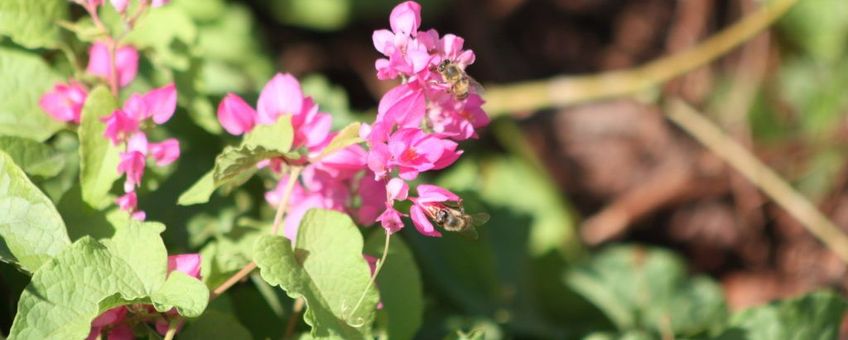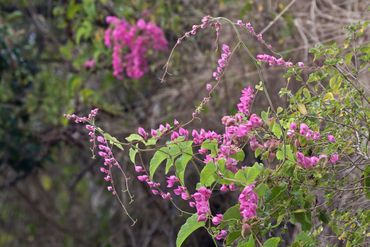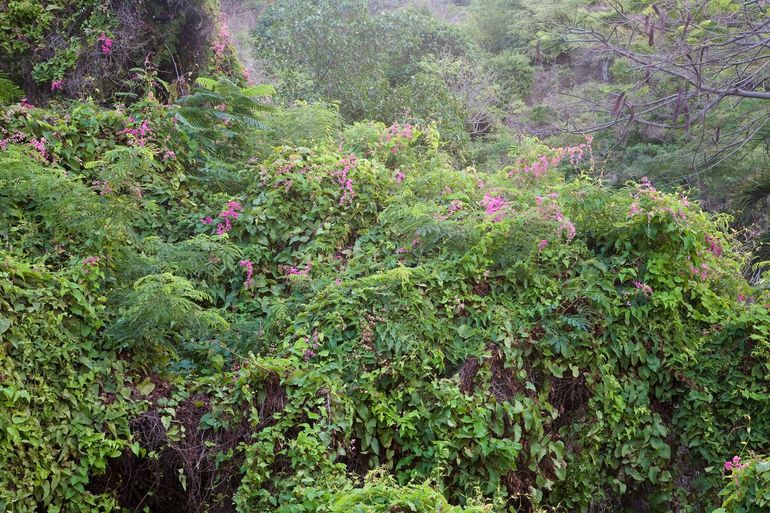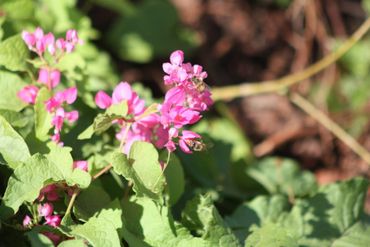
Invasive coralita threatens biodiversity of Dutch Caribbean
Dutch Caribbean Nature Alliance (DCNA)It is easy to fall in love with coralita. This ornamental plant, also known as the coral vine (Antigonon leptopus), was introduced to a number of Caribbean islands as a garden accessory in the 1940s. Its brightly colored flowers and quickly growing vines make quite the statement piece in any garden. In its native territory, growth of this plant is limited by droughts, however in the Dutch Caribbean this plant has been flourishing. Whether it’s due to the more humid climate of the northern three islands or along water collection points such as roads and drainage channels, this plant is a threat across all six Dutch Caribbean islands.
Consequences
 Coralita can spread very quickly. Its vines can reach up to 15 meters in length and rapidly cover entire areas of land. This vine is able to spread both horizontally (across fields) or vertically (up trees and buildings), smothering native vegetation beneath it. In addition, this decrease in native flora is also impacting local insect and spider communities. In fact, researchers from the Vrije Universiteit Amsterdam were able to demonstrate that on St. Eustatius, in areas of dense coralita, there was a decrease in native insects and spiders. Although often thought of as pests, these creatures play a critical role in the local ecosystem by serving as pollinators, aiding in decomposition and nutrient cycling as well as serving as a food source for native reptiles and birds. Decrease in native vegetation and thus a decrease in insects and spiders will have a cascading effect in limiting the biodiversity of these islands in the future.
Coralita can spread very quickly. Its vines can reach up to 15 meters in length and rapidly cover entire areas of land. This vine is able to spread both horizontally (across fields) or vertically (up trees and buildings), smothering native vegetation beneath it. In addition, this decrease in native flora is also impacting local insect and spider communities. In fact, researchers from the Vrije Universiteit Amsterdam were able to demonstrate that on St. Eustatius, in areas of dense coralita, there was a decrease in native insects and spiders. Although often thought of as pests, these creatures play a critical role in the local ecosystem by serving as pollinators, aiding in decomposition and nutrient cycling as well as serving as a food source for native reptiles and birds. Decrease in native vegetation and thus a decrease in insects and spiders will have a cascading effect in limiting the biodiversity of these islands in the future.

Innovative Ideas
Luckily, islands have some creative ways of combating this issue. In 2018, individuals from the St. John’s community on Saba planted five lemon trees to bring attention to and work towards the eradication of the invasive vine. Land was selected and cleared, to be used as a fruit orchard, both working to eliminate coralita and provide a source of fresh fruits for the island. Overall, this project served to encourage community action (planting lemon trees) to achieve a common goal (removing coralita).
On St. Eustatius, researchers have found a novel way to use a classification map to help managers to quickly identify dense areas of coralita. In fact, using this method, they showed that coralita is not randomly spread across the island, but typically found along roads and drainage channels. Overall, the vine was found more commonly in grasslands, disturbed natural areas and urban sites and rarely in undisturbed natural forests. This information will be key in constructing an invasive species management for the island.
Future work
 The impact of coralita on the Dutch Caribbean is significant. It not only threatens the biodiversity of the islands, but it also has economic consequences, such as reduced tourism appeal and increased costs of removal efforts. Education is an important first step to getting involved in local conservation efforts. Current efforts include manual removal by trained volunteers and the use of herbicides to control the plant's growth. In addition, awareness campaigns are being conducted to educate residents and visitors on the importance of protecting native vegetation and preventing the spread of invasive species.
The impact of coralita on the Dutch Caribbean is significant. It not only threatens the biodiversity of the islands, but it also has economic consequences, such as reduced tourism appeal and increased costs of removal efforts. Education is an important first step to getting involved in local conservation efforts. Current efforts include manual removal by trained volunteers and the use of herbicides to control the plant's growth. In addition, awareness campaigns are being conducted to educate residents and visitors on the importance of protecting native vegetation and preventing the spread of invasive species.
DCNA
The Dutch Caribbean Nature Alliance (DCNA) supports science communication and outreach in the Dutch Caribbean region by making nature related scientific information more widely available through amongst others the Dutch Caribbean Biodiversity Database, DCNA’s news platform BioNews and through the press. This article is part of a series of articles on ‘Invasive Alien Species in the Dutch Caribbean'. This article contains the results from several scientific studies, but the studies themselves are not DCNA studies. No rights can be derived from the content. DCNA is not liable for the content and the in(direct) impacts resulting from publishing this article.
Text: Dutch Caribbean Nature Alliance (DCNA)
Pictures: Jasper Molleman; Marjolijn Lopes Cardozo; Achsah Mitchell
